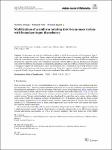Search
Author
- Carlos, Alegría (2)
- Carlos, Seara (2)
- David, Orden (2)
- Klaus, Bretterbauer (2)
- next >
Subject
Date issued
Search Results
In this paper, we propose a new inertial iterative method to solve classical variational inequalities with pseudomonotone and Lipschitz continuous operators in the setting of a real Hilbert space. The proposed iterative scheme is basically analogous to the extragradient method used to solve the problems of variational inequalities in real Hilbert spaces. The strong convergence of the proposed algorithm is set up with the prior knowledge of Lipschitz’s constant of an operator. Finally, several computational experiments are listed to show the applicability and efficiency of the proposed algorithm. |
We consider a Dirichlet problem driven by the anisotropic (p(z), q(z))-Laplacian, with a parametric reaction exhibiting the combined effects of singular and concave-convex nonlinearities. The superlinear term may change sign. Using variational tools together with truncation and comparison techniques, we prove a global (for the parameter λ>0
) existence and multiplicity theorem (a bifurcation-type theorem). |
This paper deals with the analysis of the time-fractional diffusion-wave equation as one-dimensional problem in a large plane wall, long cylinder, and sphere. The result of the analysis is the proposal of one general mathematical model that describes various geometries and different processes. Finite difference method for solving the time-fractional diffusion-wave equation using Grünwald-Letnikov definition for homogeneous or inhomogeneous material and for homogeneous or inhomogeneous boundary conditions is described. Dirichlet, Neumann and Robin boundary conditions are considered. Implementation of numerical methods for explicit, implicit, and Crank-Nicolson scheme were realised in MATLAB. Finally, illustrative examples of simulations using the developed toolbox are presented. |
We present an evolutionary model which allows us to study the impact relationship-specific investment has on bargaining. Agents are matched to play an investment and bargaining game. During bargaining, agents have an outside option to form a new relationship, but in exercising this option loses their current investment. We find that the stochastically stable post-investment bargaining convention is dependent on the cost of investment. In particular, the larger the cost of investment, the lower is the share of gross surplus that is received. This stands in contrast with previous studies. In addition, we find that there is under-investment. We disentangle the forces which lead to these two results. |
Let A be a finite-dimensional algebra over an algebraically closed field. We use a functorial approach involving torsion pairs to construct embeddings of endomorphism algebras of basic projective A–modules P into those of the torsion submodules of P. As an application, we show that blocks of both the classical and quantum Schur algebras S(2,r) and Sq(2,r) in characteristic p > 0 are Morita equivalent as quasi-hereditary algebras to their Ringel duals if they contain 2pk simple modules for some k. |
A simple drawing D(G) of a graph G is one where each pair of edges share at most one point: either a common endpoint or a proper crossing. An edge e in the complement of G can be inserted into D(G) if there exists a simple drawing of G+e extending D(G). As a result of Levi’s Enlargement Lemma, if a drawing is rectilinear opseudolinear), that is, the edges can be extended into an arrangement of lines (pseudolines), then any edge in the complement of G can be inserted. In contrast, we show that it is NP-complete to decide whether one edge can be inserted into a simple drawing. This remains true even if we assume that the drawing is pseudocircular, that is, the edges can be extended to an arrangement of pseudocircles. |
Finite elements with polynomial basis functions on the simplex with a symmetric distribution of nodes should have a unique polynomial representation. Unisolvence not only requires that the number of nodes equals the number of independent polynomials spanning a polynomial space of a given degree, but also that the Vandermonde matrix controlling their mapping to the Lagrange interpolating polynomials can be inverted. Here, a necessary condition for unisolvence is presented for polynomial spaces that have non-decreasing degrees when going from the edges and the various faces to the interior of the simplex. |
In Tao 2016, the author constructs an averaged version of the deterministic three-dimensional Navier–Stokes equations (3D NSE) which experiences blow-up in finite time. In the last decades, various works have studied suitable perturbations of ill-behaved deterministic PDEs in order to prevent or delay such behavior. A promising example is given by a particular choice of stochastic transport noise closely studied in Flandoli et al. 2021. We analyze the model in Tao 2016 in view of these results and discuss the regularization skills of this noise in the context of the averaged 3D NSE. |
We consider final state observability estimates for bi-continuous semigroups on Banach spaces, i.e. for every initial value, estimating the state at a final time T>0 by taking into account the orbit of the initial value under the semigroup for t∈[0,T], measured in a suitable norm. We state a sufficient criterion based on an uncertainty relation and a dissipation estimate and provide two examples of bi-continuous semigroups which share a final state observability estimate, namely the Gauß–Weierstraß semigroup and the Ornstein–Uhlenbeck semigroup on the space of bounded continuous functions. |
In this paper, we study the stabilization problem of a disk beam structure with disturbance. Specifically, the structure consists of a beam clamped at one end to the center of a rotating rigid disk, while the other end is attached to a tip mass subject to a non-uniform bounded disturbance. We start the investigation by designing the controller via the Active disturbance rejection control (ADRC) approach. The high gain extended state observer (ESO) is first designed to estimate the disturbance, then the feedback observer-based controller is designed to employ the estimation to cancel the disturbance effect. |










